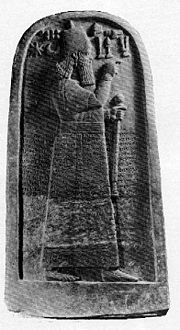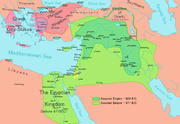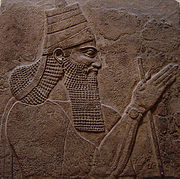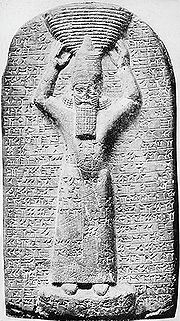- List of Assyrian kings
-
Ancient
MesopotamiaEuphrates · Tigris Sumer Eridu · Kish · Uruk · Ur
Lagash · Nippur · GirsuElam Susa · Anshan Akkadian Empire Akkad · Mari Amorites Isin · Larsa Babylonia Babylon · Chaldea Assyria Assur · Nimrud
Dur-Sharrukin · NinevehMesopotamia (Dynasty list) Sumer (king list) Kings of Elam
Kings of Assyria
Kings of BabylonEnûma Elish · Gilgamesh Assyrian religion Sumerian · Elamite Akkadian · Aramaic Hurrian · Hittite The list of Assyrian kings is compiled from the Assyrian King List, an ancient kingdom in northern Mesopotamia (modern northern Iraq) with information added from recent archaeological findings. The Assyrian King List includes regnal lengths that appear to have been based on now lost limmu lists (which list the names of eponymous officials for each year). These regnal lengths accord well with Hittite, Babylonian and ancient Egyptian king lists and with the archaeological record, and are considered reliable for the age.[1]
Prior to the discovery of cuneiform tablets listing ancient Assyrian kings, scholars before the 19th century only had access to two complete Assyrian King Lists, one found in Eusebius of Caesarea's Chronicle (c. 325 AD), of which two editions exist[2] and secondly a list found in the Excerpta Latina Barbari.
An incomplete list of 16 Assyrian kings was also discovered in the literature of Sextus Julius Africanus. Other very fragmentary Assyrian king lists have come down to us written by the Greeks and Romans such as Ctesias of Cnidus (c. 400 BC) and the Roman authors Castor of Rhodes (1st century BC) and Cephalion (1st century AD).
Unlike the cuneiform tablets, the "other" Assyrian King Lists are not considered to be wholly factual (since they contain some mythological figures) and thus are only considered to contain minor historical truths. Some scholars argue further that they are either entire fabrications or fiction.
Contents
Cuneiform Sources
There are three extant cuneiform tablet versions of the King List, and two fragments.[3] They date to the early first millennium BC—the oldest, List A (8th century BC) stopping at Tiglath-Pileser II (ca. 967–935 BC) and the youngest, List C, at Shalmaneser V (727–722 BC). Assyriologists believe the list was originally compiled to link Shamshi-Adad I (fl. ca. 1700 BC (short)), an Amorite who had conquered Assur, to the native rulers of the land of Assur. Scribes then copied the List and added to it over time.[4]
Fragmentary Greek and Roman Lists
Ctesias
Ctesias as court physician to Artaxerxes II, claimed to have access to the royal historical records. Ctesias' list of Assyrian kings was included in his Persica, a work covering the history of Persia, but the first 3 books were dedicated to pre-Persian Assyria entitled "The History of the Assyrians". How much of Ctesias' king list is factual history is still debated, while most scholars agree large parts are fiction, it is generally agreed that there is historical truth based on the probability his list was rooted in transmitted oral tradition.[5][6] Classical scholar Robert Drews however has argued that Ctesias' list contains information from Babylonian tablets.[7] Although Ctesias's entire work is lost, fragments of it are found preserved in Diodorus Siculus, Nicolaus of Damascus and Photius. From these fragments it is known Ctesias dated the founding of the Assyria to c. 2166 BC, by king Ninus, husband of Queen Semiramis, and 30 further Assyrian kings followed for 1300 years in succession to Sardanapalus (c. 866 BC). [8] Ctesias' list of 30 successors from Ninus (and Semiramis) to Sandanapalus is lost.
Castor of Rhodes and Cephalion
In the 1st century BC, Castor of Rhodes compiled an Assyrian King List, similar to that of Ctesias'. However fragments only remain in mutilated form, but it is known from these fragments that Castor's Assyrian king list started with Belus, but like Ctesias' included Ninus, also said to be the husband of Semiramis. However Ninus equates in Castor's list to the second king, not the first and is said to have ruled for 52 years. Castor further dated Belus to 2123 BC.[9] A fragment from Cephalion, names Ninus' successor to be Ninyas, his son.
Africanus' List
An incomplete list of 16 Assyrian kings is found in Sextus Julius Africanus' Chronographiai (early 3rd century AD):[10]
“ Of the Assyrian Kings the 1st was Belus who reigned 55 years. Ninus .. .. 52 years. Semiramis .. .. 42. Ninaus (Ninyas?) who is called Zamis the son of Ninus and Semiramis; he reigned 38 years. Arius .. .. 30 years. Aralius .. .. .. 40. Xerxes .. .. .. 30. Armamithres .. 38. Belochos .. .. 35. Balaeus .. .. .. 52. Sethos .. .. .. 50. Mamuthos .. .. 30. Aschalius .. .. 28. Sphaerus .. .. 22. Mamulus .. .. 30. Spartheos .. .. 42. ” Eusebius' List
Eusebius of Caesarea's Chronicle (c. 325 AD), contains a complete list of 36 Assyrian kings. Eusebius' King List
Excerpta Latina Barbari
A final list is found in the Excerpta Latina Barbari. The list can be found in Scaliger's Thesaurus temporum (1606). The list dates Belus, the first Assyrian king to c. 2206 BC.[11]
List in Arabic
The Arab historian al-Ya'qūbī included in his Kitāb al-ta'rīkh written in 873 CE a list of kings of "Mosul and Nineveh" comprising four identifiable Assyrian kings: Palūs/Tiglath-pileser II (965-936), Ninūs/Tukulti-Ninurta II (890-884), Lāwasnasir/Assurnasirpal II (883-859) and Shamīram/Semiramis (810-806).[12]
List of Kings
The following kings are listed from the cuneiform tablets.
Early Period
No regnal lengths are given for kings before Erishum I.
Kings who Lived in Tents
This section shows marked similarities to the ancestors of the first Babylonian dynasty.[4]
Kings whose Fathers are Known
These list the ancestors of Shamshi-Adad I.[4]
- Apiashal, "son of Ushpia"
- Hale, "son of Apiashal"
- Samani, "son of Hale"
- Hayani, "son of Samani"
- Ilu-Mer, "son of Hayani"
- Yakmesi, "son of Ilu-Mer"
- Yakmeni, "son of Yakmesi"
- Yazkur-el, "son of Yakmeni"
- Ila-kabkabu, "son of Yazkur-el"
- Aminu, "son of Ila-kabkabu"
Kings whose Eponyms are not Known
These are early rulers of Assyria.[4]
Old Assyrian Period King name Reigned Sulili unknown 21st c BC "son of Aminu" Kikkiya unknown 21st c BC "son of Sulili" Akiya unknown 21st or early 20th C BC "son of Kikkiya" Puzur-Ashur I fl. ca. 1975 BC Founded new Dynasty, dedicated temples in Ashur, founded colonies in Asia Minor[17] Contemporary of Ishbi-Erra of Larsa Shalim-ahum died 1946 BC "son of Puzur-Ashur I" Ilu-shuma fl. ca. 1945 - 1906 BC raided Sumero-Akkadian City States in southern Mesopotamia Old Assyrian Period
Damage to the tablets in all three extant King Lists before Enlil-nasir II (ca. 1420–1415 BC (short)) prevents the calculation of approximate regnal dates from Erishum I to this point. Additionally, three kings attested elsewhere from this period are not included in the standard King List. The remainder of the King List then has an unbroken chain of regnal lengths from Enlil-nasir II on. Disparities between the different versions of the King List for the reigns of Ashur-nadin-apli (ca. 1196–1194 BC (short)) and Ninurta-apal-Ekur (ca. 1182–1180 BC (short)) contribute to the debate over the chronology of the ancient Near East.[4][18] Georges Roux and A. Leo Oppenheim provide dates in their King Lists, but these are open to debate[19]
Old Assyrian Period King name Reigned[20][21] Notes[20][21] Erishum I fl. ca. 1905-1867 BC
(30 or 40 years)"son of Ilu-shuma"; contemporary of Sumuabum first ruler of Babylonia; said to have built the temple of Ashur Ikunum 1867 - 1860 BC (damaged text) "son of Ilushuma" 1867 - 1860 BC Sargon I ca. 1859 BC - ?(damaged text) "son of Ikunum" Puzur-Ashur II (damaged text) "son of Sargon (I)" Naram-Suen (Naram-Sin) (damaged text) "son of Puzur-Ashur (II)" Erishum II 1819 - 1814 BC (damaged text) "son of Naram-Suen" Shamshi-Adad I fl. ca. 1813 - 1791 BC "son of (local ruler) Ila-kabkabu, went to Karduniash in the time of Naram-Suen. In the eponymy of Ibni-Adad, Shamshi-Adad went up from Karduniash. He took Ekallatum, where he stayed three years. In the eponymy of Atamar-Ishtar, Shamshi-Adad went up from Ekallatum. He ousted Erishum II, son of Naram-Suen, from the throne and took it."; Ishme-Dagan I 1790 - 1751 BC "son of Shamshi-Adad (I)" Mut-Ashkur 1750 BC - (unknown) Vassal of Hammurabi, son of Ishme-Dagan I, married to a Hurrian queen; not included in the standard King List, but attested elswhere[22] Rimush (unknown) included in the alternative King List fragment, last part of name lost; (believed to be Rimush by Georges Roux) not included in the standard King List[22] Was a vassal of Hammurabi Asinum (unknown) grandson of Shamshi-Adad I, driven out by vice-regent Puzur-Sin because he was of Amorite extraction; not included in the standard King List, but attested in Puzur-Sin's inscription[22] Seven usurpers: - Ashur-dugul
- Ashur-apla-idi
- Nasir-Sin
- Sin-namir
- Ipqi-Ishtar
- Adad-salulu
Adasi circa 1720 - 1701 BC Drove Babylonians and Amorites from Assyria circa 1720 BC Bel-bani 1700 - 1691 BC (10 years) "son of Adasi" Libaya 1690-1674 BC (17 years) "son of Bel-bani" Sharma-Adad I 1673-1662 BC (12 years) "son of Libaya" Iptar-Sin 1661-1650 BC (12 years) "son of Sharma-Adad (I)" Bazaya 1649-1622 BC (28 years) "son of Iptar-Suen" Lullaya (1621-1618 BC (6 years) "son of a nobody" Shu-Ninua 1615-1602 BC (14 years) "son of Bazaya" Sharma-Adad II 1601-1599 BC (3 years) "son of Shu-Ninua" Erishum III 1598-1586 BC (13 years) "son of Shu-Ninua" Shamshi-Adad II 1585-1580 BC(6 years) "son of Erishum (III)" Ishme-Dagan II 1579 - 1562 BC (16 years) "son of Shamshi-Adad (II)" Shamshi-Adad III 1562 - 1548 BC (16 years) " son of (another) Ishme-Dagan, brother of Sharma-Adad (II), son of Shu-Ninua" Ashur-nirari I 1547 - 1522 BC (26 years) "son of Ishme-Dagan II" Puzur-Ashur III 1521-1498 BC "son of Ashur-nirari (I)"; contemporary of Burna-Buriash I of Babylonia[13] Fortified Ashur Enlil-nasir I 1497 - 1484 BC (13 years) "son of Puzur-Ashur (III)" Nur-ili circa 1483 - 1471 BC (12 years) "son Enlil-nasir (I)" Vassal of the Mitanni Empire Ashur-shaduni circa 1471 BC (1 month) "son of Nur-ili" Ashur-rabi I circa 1470 - 1451 BC (uncertain, damaged text) "son of Enlil-nasir (I), ousted him (Ashur-shaduni), (and) seized the throne" Ashur-nadin-ahhe I circa 1450 - 1431 (uncertain, damaged text) "son of Ashur-rabi (I)" Enlil-nasir II ca. 1430–1425 BC "his (Ashur-nadin-ahhe I's) brother, ousted him" Ashur-nirari II ca. 1424–1418 BC "son of Enlil-nasir (II)" Ashur-bel-nisheshu ca. 1417–1409 BC "son of Ashur-nirari (II)" Ashur-rim-nisheshu ca. 1408–1401 BC "son of Ashur-bel-nisheshu" Ashur-nadin-ahhe II ca. 1400–1391 BC "son of Ashur-rim-nisheshu" Middle Assyrian Period
The dates up to Ninurta-apal-Ekur (ca. 1182–1180 BC) are subject to debate, as some of the regnal lengths vary over the different versions of the King List. The dates given below are based on Assyrian King Lists B and C, which give only three years to Ashur-nadin-apli, and the same to Ninurta-apal-Ekur. (Assyrian King List A gives four years to Ashur-nadin-apli and 13 years to Ninurta-apal-Ekur.[23]) This timeframe is also subject to the overall debate about the chronology of the ancient Near East; the short (or low) chronology is used here.
Dates from 1179 to 912 BC, although less secure than dates from 911 BC onwards, are not subject to the chronology debate.[13]
 Adad-nirari I (ca. 1295–1263 BC)
Adad-nirari I (ca. 1295–1263 BC)
Middle Assyrian Period King name Reigned[24][25][26] Notes[20][21] Eriba-Adad I ca. 1390–1364 BC "son of Ashur-bel-nisheshu" Ashur-uballit I ca. 1363–1328 BC "son of Eriba-Adad (I)" Enlil-nirari ca. 1327–1318 BC "son of Ashur-uballit" Arik-den-ili ca. 1317–1306 BC "son of Enlil-nirari" Adad-nirari I ca. 1305–1274 BC "son of Arik-den-ili" Shalmaneser I ca. 1273–1244 BC "son of Adad-nirari (I)" Tukulti-Ninurta I ca. 1243–1207 BC "son of Shalmaneser (I)" Ashur-nadin-apli ca. 1206–1203 BC "during the lifetime of Tukulti-ninurta (I), Ashur-nadin-apli, his son, seized the throne" Ashur-nirari III ca. 1202–1197 BC "son of Ashur-nadin-apli" Enlil-kudurri-usur ca. 1196–1192 BC "son of Tukulti-Ninurta (I)" Ninurta-apal-Ekur ca. 1191–1180 BC "son of Ila-Hadda, a descendant of Eriba-Adad (I), went to Karduniash. He came up from Karduniash (and) seized the throne." Beginning with Ashur-Dan I, dates are consistent and not subject to middle/short chronology distinctions. Ashur-Dan I ca. 1179–1133 BC "son of Ashur-nadin-apli" Ninurta-tukulti-Ashur ca. 1133 BC "son of Ashur-dan (I), briefly" Mutakkil-nusku ca. 1133 BC "his (Ninurta-tukulti-Ashur's) brother, fought him and took him to Karduniash. Mutakkil-Nusku held the throne briefly, then died." Ashur-resh-ishi I ca. 1133–1115 BC "son of Mutakkil-Nusku" Tiglath-Pileser I ca. 1115–1076 BC "son of Ashur-resh-ishi (I)" Asharid-apal-Ekur ca. 1076–1074 BC "son of Tiglath-pileser (I)" Ashur-bel-kala ca. 1074–1056 BC "son of Tiglath-pileser (I)" Eriba-Adad II ca. 1056–1054 BC "son of Ashur-bel-kala" Shamshi-Adad IV ca. 1054–1050 BC "son of Tiglath-pileser (I), came up from Karduniash. He ousted Eriba-Adad (II), son of Ashur-bel-kala, (and) seized the throne" Ashur-nasir-pal I ca. 1050–1031 BC "son of Shamshi-Adad (IV)" Shalmaneser II ca. 1031–1019 BC "son of Ashur-nasir-pal (I)" Ashur-nirari IV ca. 1019–1013 BC "son of Shalmaneser (II)" Ashur-rabi II ca. 1013–972 BC "son of Ashur-nasir-pal (I)" Ashur-resh-ishi II ca. 972–967 BC "son of Ashur-rabi (II)" Tiglath-Pileser II ca. 967–935 BC "son of Ashur-resh-ishi (II)" Ashur-Dan II ca. 935–912 BC "son of Tiglath-Pileser (II)" Neo-Assyrian Period
 Neo-Assyrian Empire (824 & 671 BC)
Neo-Assyrian Empire (824 & 671 BC)
 Tiglath-Pileser III (745–727 BC)
Tiglath-Pileser III (745–727 BC)
 Ashurbanipal (669–631 BC)
Ashurbanipal (669–631 BC)
Synchronisms between the limmu lists and absolute dates known from Babylonian chronology provide good absolute dates for the years between 911 BC and 649 BC.
The dates for the very end of the Assyrian period are uncertain due to the lack of limmu lists after 649 BC. Some sources list Ashurbanipal's death in 631 BC, rather than 627 BC; Ashur-etil-ilani then reigns from 631 to 627, and Sin-shar-ishkun reigns until 612 BC, when he is known to have died in the sack of Nineveh.[13]
Neo-Assyrian Period King name Reigned[27][28][29] Notes[20][21] Adad-nirari II 912–891 BC "son of Ashur-Dan (II)" Tukulti-Ninurta II 891–884 BC "son of Adad-nirari (II)" Ashur-nasir-pal II 884–859 BC "son of Tukulti-Ninurta (II)" Shalmaneser III 859–824 BC "son of Ashur-nasir-pal (II)" Shamshi-Adad V 824–811 BC "son of Shalmaneser (III)" Semiramis (Shammu-ramat), regent, 811–808 BC Adad-nirari III 811–783 BC "son of Shamshi-Adad (V)" Shalmaneser IV 783–773 BC "son of Adad-nirari (III)" Ashur-Dan III 773–755 BC "son of Shalmaneser (IV)"; solar eclipse 763 BC[13] Ashur-nirari V 755–745 BC "son of Adad-nirari (III)" Tiglath-Pileser III 745–727 BC "son of Ashur-nirari (V)" Shalmaneser V 727–722 BC "son of Tiglath-Pileser (III)" End of the document known as Assyrian King List; the following kings reigned after the list had been composed. Sargon II 722–705 BC Sennacherib 705–681 BC Esarhaddon 681–669 BC The dates of the last kings are not certain. Ashurbanipal 669–between 631 and 627 BC Ashur-etil-ilani ca. 631–627 BC Sin-shumu-lishir 626 BC Sin-shar-ishkun ca. 627–612 BC fall of Nineveh In 612 BC, Nineveh, the Assyrian capital, fell to the Medes, Babylonians, and Scythians; supported by the Egyptians, an Assyrian general continued to rule for a few years from Harran. Ashur-uballit II 612 BC–ca. 608 to 605 BC Harran defeated by Cyaxares of Media and Nabopolassar of Babylonia, Assyrian-Egyptian force defeated at Carchemish in 605 BC See also
- Assyrian King List
- List of ancient king lists
- Chronology of the ancient Near East
- Short chronology timeline
- Sumerian King List
- List of kings of Babylon
- List of Hittite kings
- List of pharaohs
Notes
- ^ Rowton, M.B. (1970). The Cambridge Ancient History. 1.1. Cambridge University Press. pp. 194–195. ISBN 0521070511. http://books.google.com/books?id=7SOL7ypj7bAC&printsec=frontcover&cad=0#PPA194,M1.
- ^ One the standard the other a later Armenian translation.
- ^ For discussion of king lists, see Poebel, “Assyrian King List,” 71–90; IJ Gelb, “Two Assyrian King Lists,”Journal of Near Eastern Studies 13 (1954): 209–30.
- ^ a b c d e Meissner, Bruno (1990). Reallexikon der Assyriologie. 6. Berlin: Walter de Gruyter. pp. 101–102. ISBN 3110100517. http://books.google.com/books?id=OIeiZaIo91IC&printsec=frontcover&cad=0#PPA101,M1.
- ^ "Ctesias' Persian History: Introduction, text, and translation", Jan P. Stronk, Wellem Verlag, 2010, pp.30-36.
- ^ Felix Jacoby cf. FGrH 688 T 11, T 13, T 19, shows ancient authorities that considered the king list to be sensational, semi-fictional or unrealistic at the time.
- ^ Assyria in Classical Universal Histories, Robert Drews, Historia: Zeitschrift für Alte Geschichte, Bd. 14, H. 2 (Apr., 1965), pp. 129-142
- ^ Drews, 1965, p. 30.
- ^ "Ovid, Varro, and Castor of Rhodes: The Chronological Architecture of the 'Metamorphoses'", Thomas Cole, Harvard Studies in Classical Philology, Vol. 102, (2004), pp. 355-422.
- ^ Preserved by George Syncellus, found in Cory's Ancient Fragments, 1826, p. 70.
- ^ The Assyrian King list in the Excerpta Latina Barbari claims Belus ruled 1430 years before the first Olympiad (776 BC) thus dating him to 2206 BC.
- ^ Dierk Lange, The founding of Kanem by Assyrian Refugees ca. 600 BCE: Documentary, Linguistic, and Archaeological Evidence, Boston, 2011, p. 29.
- ^ a b c d e Rowton, M.B. (1970). The Cambridge Ancient History. 1.1. Cambridge University Press. pp. 202–204. ISBN 0521070511. http://books.google.com/books?id=7SOL7ypj7bAC&printsec=frontcover&cad=0#PPA202,M1.
- ^ a b Glassner, Jean-Jacques (2004). Mesopotamian Chronicles. Society of Biblical Literature. pp. 137. ISBN 1589830903. http://books.google.com/books?id=1i5b6STWnroC&printsec=frontcover&cad=0#PPA137,M1.
- ^ Meissner, Bruno (1990). Reallexikon der Assyriologie. 6. Berlin: Walter de Gruyter. pp. 103. ISBN 3110100517. http://books.google.com/books?id=OIeiZaIo91IC&printsec=frontcover&cad=0#PPA103,M1.
- ^ Meissner, Bruno (1990). Reallexikon der Assyriologie. 6. Berlin: Walter de Gruyter. pp. 104. ISBN 3110100517. http://books.google.com/books?id=OIeiZaIo91IC&printsec=frontcover&cad=0#PPA104,M1.
- ^ Georges Roux - Ancient Iraq
- ^ Rowton, M.B. (1970). The Cambridge Ancient History. 1.1. Cambridge University Press. pp. 195. ISBN 0521070511. http://books.google.com/books?id=7SOL7ypj7bAC&printsec=frontcover&cad=0#PPA195,M1.
- ^ Georges Roux - Ancient Iraq and A. Leo Oppenheim - Ancient Mesopotamia
- ^ a b c d Glassner, Jean-Jacques (2004). Mesopotamian Chronicles. Society of Biblical Literature. pp. 136–144. ISBN 1589830903. http://books.google.com/books?id=1i5b6STWnroC&printsec=frontcover&cad=0#PPA136,M1.
- ^ a b c d Lendering, Jona (31 March 2006). "Assyrian King List". http://www.livius.org/k/kinglist/assyrian.html. Retrieved 2008-08-13.
- ^ a b c Glassner, Jean-Jacques (2004). Mesopotamian Chronicles. Society of Biblical Literature. pp. 88. ISBN 1589830903. http://books.google.com/books?id=1i5b6STWnroC&printsec=frontcover&cad=0#PPA88,M1.
- ^ For variants, see footnotes 49–56 in Glassner, Jean-Jacques (2004). Mesopotamian Chronicles. Society of Biblical Literature. pp. 155. ISBN 1589830903. http://books.google.com/books?id=1i5b6STWnroC&printsec=frontcover&cad=0#PPA155,M1.
- ^ Comments on the Nassouhi Kinglist and the Assyrian Kinglist Tradition, J.A. Brinkman, Orientalia N.S 42, 1973
- ^ Assyrian Rulers of the Third and Second Millennia BC, A.K. Grayson, University of Toronto Press, 1987, ISBN 0-8020-2605-2
- ^ The Chronology of Ancient Assyria Re-assessed, B. Newgrosh, JACF, vol. 08, pp. 78-106, 1999
- ^ Landscape and Settlement in the Neo-Assyrian Empire, T. J. Wilkinson, E. B. Wilkinson, J. Ur, M. Altaweel, Bulletin of the American Schools of Oriental Research, November 2005
- ^ [1] Neo-Assyrian Eponym List—Livius.org
- ^ [2] Empires and Exploitation: The Neo-Assyrian Empire, P Bedford, WA Perth, 2001
References
- Ascalone, Enrico (2007). Mesopotamia: Assyrians, Sumerians, Babylonians (Dictionaries of Civilizations; 1). Berkeley: University of California Press. ISBN 0520252667.
- Grayson, Albert Kirk (1975). Assyrian and Babylonian Chronicles. Locust Valley, N.Y..
- Healy, Mark (1992). The Ancient Assyrians. ISBN 978-1-85532-163-2.
- Leick, Gwendolyn (2003). Mesopotamia. ISBN 0140265740.
- Lloyd, Seton (1984). The Archaeology of Mesopotamia: From the Old Stone Age to the Persian Conquest. ISBN 0500790094.
- Nardon, Don (1998). Assyrian Empire. ISBN 1560063130.
External links
Categories:- Assyrian kings
- Lists of monarchs
- History of Iraq
- Hebrew Bible people
- King lists
Wikimedia Foundation. 2010.
